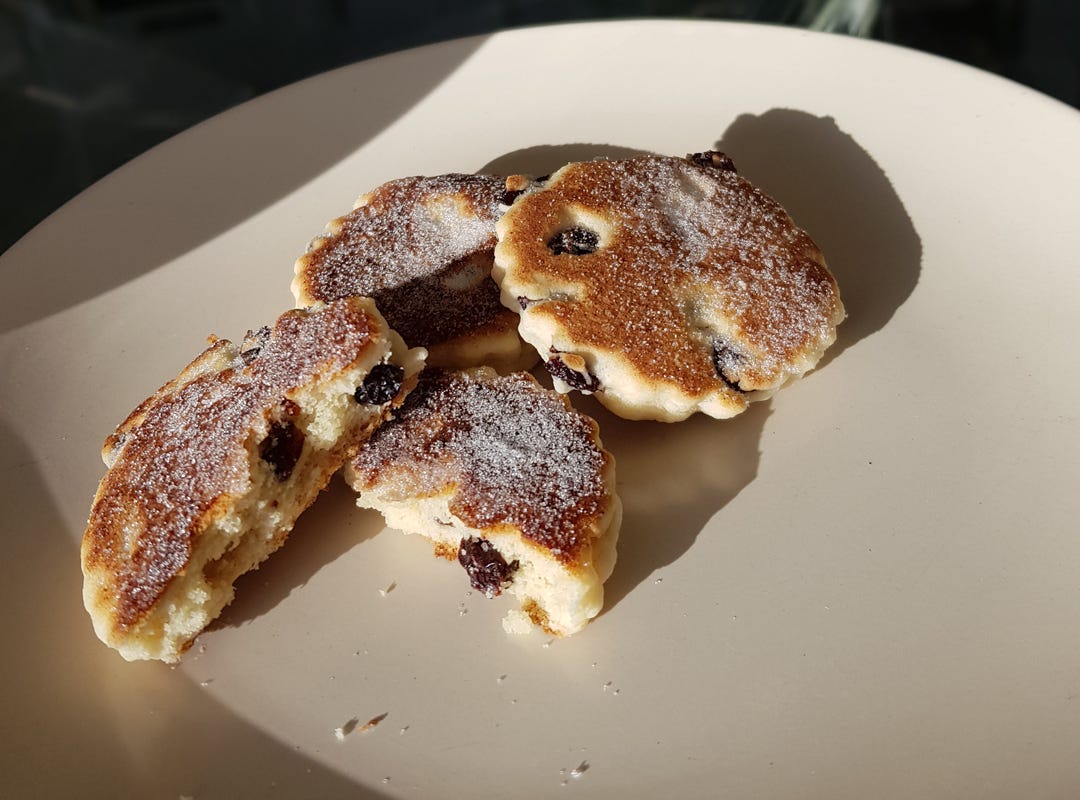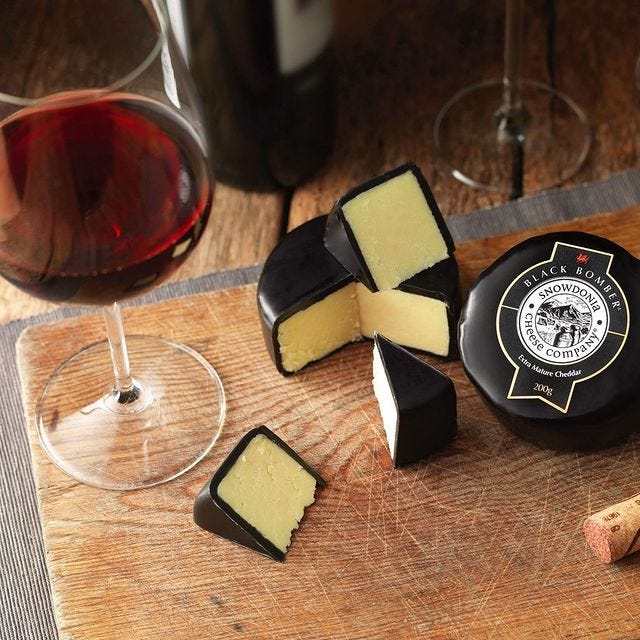"‘The Welsh,’ said the Doctor, ‘are the only nation in the world that has produced no graphic or plastic art, no architecture, no drama. They just sing,’” Or so says Dr Fagan in Evelyn Waugh’s Decline and Fall. And while it is true that Welsh people do and will sing, I would argue that the land of my fathers has always been a country of great note, and rather overlooked for its culinary and creative value. But this is not a newsletter about defending Wales from fictional quotes, it’s about celebrating Wales, its culture, cultivation and cuisine.
So, what is Welsh food? In a word, I would say: nourishing. And by that, I mean the best of ingredients sourced from both the bountiful waters that surround three sides of the country, and the verdant and rugged countryside, and the ways in which these ingredients are used and savoured. It’s about hearty stews to ward off bleak winters, cockles doused in vinegar from a market stall – yards from where they were collected – dishes muddled together to make do with what’s leftover, nose-to-tail eating, and meals that transport you straight back home with a warm glow.
Wales is brimming with independent suppliers and producers with offerings ranging from salt to spiced rum, cheese to wine. Of course, great produce in Wales is nothing new – we’ve had the natural resources for centuries. And they’ve been exported all over the world, along with their traditions and recipes (as well as coal and steel).
Head to Argentinian Patagonia to visit the Welsh tea houses serving Patagonia Black Cake – known there as torta galesa (Welsh Cake) – a rich fruit cake often laced with rum and glazed in a light sugar crust, a hand-me-down from the Welsh settlers there in the late 19th century. Or perhaps head to Matakana on New Zealand’s North Island to try one of the best Welsh rarebits I’ve ever eaten. For a nation of only three million people, we sure do get about and seemingly never stop eating, drinking and entertaining.
Yes, this is going to be a newsletter about lamb and leeks, but then that’s what we’re made of, what we’re raised on – broth and puddings to see out the rainy days that make our mountains and hills so green, and salty seaweed sure to cure any hangover. But it’s also about culture, why we are who we are, what a modern Welsh kitchen and food looks like, and how Welsh food and drink should be praised, celebrated and above all enjoyed.
I hope you find the newsletter nourishing – for the stomach and the soul.
The Recipe
Welsh Cakes
Well, this had to be the first one really, didn’t it? They are the food that seem to have defined the most important moments of my life, from starting university armed with a batch from my Great Auntie Den, ingratiating myself into a new place of work, to offering welcome sustenance to choir practices. Like most, I first learned to make these little griddle cakes from my Nan (who always used a mix of lard and butter – the more traditional method), but the recipe I use is this more modern one, which uses butter or Stork for Cakes to produce a lighter more cake-like Welsh cake. The great thing about Welsh cakes is you can make them pretty much anywhere with the most rudimentary equipment, as I hope the recipe below demonstrates. In fact, I once taught 300 Spanish high school students how to make them in a school biology lab using wine bottles for rolling pins, all manner of ‘mixing bowls’ (and plenty of AntiBac).
Ingredients (makes about 20-25)
100g hard fat (butter, lard, margarine, Stork for Cakes, Stork for Pastry, or a mix of any of these)
200g self-raising flour (or plain if it’s what you have in the cupboard) plus extra for rolling out
60g caster sugar (or granulated if it’s all you have)
80g currants (or sultanas, cranberries, dried mixed fruit etc.)
1tsp mixed spice (optional) (or ground nutmeg or ground cinnamon)
1 free-range egg
Drop of milk if needed
Icing or caster sugar for dusting (optional)
You can use gluten-free flour if needed and substitute vegan vegetable spread for the fat, and soy milk instead of the egg to make it vegan.
Equipment
You’ll need something to:
Mix in (large bowl, large Tupperware or large saucepan)
Mix with (knife, wooden spoon or hands)
Roll out (rolling pin, highball tumbler or clean empty wine bottle)
Cut out (biscuit cutter, teacup, wine glass or tumbler)
Cook on (bakestone, griddle, electric hotplate or heavy-based frying pan)
Flip with (spatula, fish slice or knife)
Method
Sift the flour into a large bowl and add the butter in small cubes. Rub together with your fingertips until it looks like breadcrumbs. Give the bowl a good shake to bring any large bits to the top, and rub them in.
Add the sugar, mixed spice and currants and stir to distribute evenly. Add the egg and mix together with a wooden spoon or a knife until you get a soft dough. Add a splash of milk if the mix is too dry. The dough should be a little sticky but form a rough ball and leave the bowl pretty clean. Pop it in the fridge for a few minutes while you clean and prepare your worktop for rolling out and preheat your bakestone on the hob on a medium heat.
Lightly flour a clean work surface and roll out the dough until it is a bit thicker than a £1 coin or a little under a centimetre. Using a pastry cutter, cut out circles of the dough. Roll and cut the excess again until all the dough is used up.
Grease the bakestone with a little butter and wipe off any excess with a piece of kitchen roll (you can then use to re-grease between each batch). Cook the Welsh cakes in batches for about three minutes on each side or until they’re just cooked through without burning. They should be slightly springy to the touch.
Remove from the bakestone, dust with sugar and serve warm with a strong cuppa.
They’ll keep for at least a week in an airtight container (or an old Fox’s Biscuits tin if in my Nannie Gwenyth’s house). If they seem a touch hard and stale, pop them in the toaster for a moment and spread with butter or jam.
If you try them out, don’t forget to tag any photos with #mywelshkitchen
The Playlist
To me, cooking and music go hand in hand, whether that’s singing at the top of your voice using a wooden spoon as a microphone while waiting for pasta to boil, or dancing around with the oven gloves on as the oven timer counts down. Here are this week’s ideas for your Welsh Kitchen playlist.
I’m from a non-Welsh-speaking family and my grasp of the Welsh language is made up of my GCSE, overhearing and reading bits and pieces, always using the cashpoint in Welsh and the MacDonald’s ordering machine, and from singing in Welsh with a choir. But just because I might not be able to understand all the lyrics, it doesn’t stop my enjoyment of Welsh-language songs. Here are two that I’ve been listening to lately.
Yr Awyr Adre by Mared
Cymer Dy Siar by Tair Chwaer (points if you remember the S4C series!)
The Pantry
Good food is nothing without good ingredients and thankfully there are plenty of fantastic Welsh products on the market. Here is where you’ll find recommendations to stock up your cupboard, fridge or fruit bowl.
Black Bomber Extra Mature Cheddar
Over Christmas, I think I ate my body weight in cheese, and yet I can always find room for a little chunk of this extra mature Cheddar from the Snowdonia Cheese Company. Black Bomber is punchy, has just the right amount of tang, and as it melts on the tongue, it’s soothingly creamy. It might be controversial to say this, but cut a few thin shavings and place on top of a Welsh cake for a joyous sweet-savoury combo.





